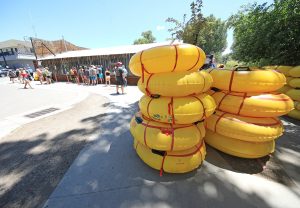City faces service cuts as 2026 sales tax projections point downward

John F. Russell/Steamboat Pilot & Today
As Steamboat Springs heads into the 2026 budget cycle, city officials are bracing for a notable slowdown in sales tax revenue growth — a reality expected to require service cuts and tough decisions across departments.
At city council’s regular meeting on Tuesday, Finance Director Kim Weber delivered a sobering sales tax projection, one that not only sets the tone for the upcoming fiscal year but also underscores the city’s dependence on sales tax as its primary source of revenue.
“We are proposing that we start the 2026 budget with a 2% decrease from the 2025 budget, which is similar to what we think we’re going to see in 2025,” Weber told council. That means the city will budget nearly $800,000 less in sales tax for 2026 compared to the current year.
According to Weber, the reduction will result in service cuts in certain areas as rising operating costs outpace available revenue.
“As you’re aware, almost 70% of our general fund budget comes from sales tax, and our financial policies require the city manager and staff to bring you a balanced budget in October for the general fund,” said Weber. “Sales tax projection is a big driver of what that balanced budget looks like.”
Steamboat’s sales tax trends over the past decade reveal a city that rode the post-pandemic economic surge. That momentum, however, is tapering off.
From 2017 through 2019, sales tax growth averaged around 6% annually, with a sharp pandemic dip in 2020, said Weber. This was followed by 21% growth in 2021 and 15% in 2022, thanks in part to pandemic-fueled migration, marketplace facilitator legislation and high inflation.
“All three of those things occurred in 2021, 2022, but now we’re seeing that fairly stable, and projecting only a 1% increase from 2024 and 2025 based on our current conditions,” Weber explained.
While inflation remains at 2-4%, above pre-pandemic norms, she added, these gains are offset by softening consumer spending and negative sentiment in the labor market.
“We use our current data, our prior year trends, consumer confidence and consumer sentiment,” she said. “We’ve found over the years that those really correlate pretty closely with our sales tax.”
Consumer sentiment in Steamboat, in particular, saw the largest drop since the 2009 recession, according to data for the first quarter of 2025.
Breaking down the sales tax sources, Weber noted that 21% comes from lodging and amenities, 16% from restaurants, and 13% from grocery and food sellers. Categories most aligned with tourism are lagging, while more local-driven sectors, like construction and retail, show some resilience.
“That tells you that visitors are not spending as much money,” said Weber, or that there is a decline in visitation.
The projected decline will force tough choices. Councilor Michael Buccino questioned whether the city could simply not fill vacant positions as a way to balance the budget.
“If we’re providing the service right now with the current employees that we have right now,” said Buccino, “could that be where we don’t have to cut our services and still stay within your 2% decrease?”
Weber responded that such a move could be possible, but isn’t without risks, referring to the Steamboat Springs Police Department as an example.
“As they have vacancies, they are utilizing overtime, and we are having employee burnout, or there’s safety concerns with utilizing that,” said Weber. “I would probably submit that we are not (currently) providing the services that we budgeted for in all areas, or we’re bringing in other people to backfill some of that. So I would be concerned.”
“I’ve challenged the staff to — when we lose folks for whatever reason, or current vacancies, to evaluate whether that’s something we really need to fill, or is there a different way to provide that service,” added City Manager Tom Leeson. “So that is something that we’re looking at and we’ll certainly evaluate that as we go through the 2026 budget as well.”
Councilor Dakotah McGinlay asked whether new taxes that, if approved, would take effect in 2026 — such as a proposed vacancy tax and/or a lift ticket tax — were figured into the projection, to which Weber confirmed that they were not.
If such measures pass later this year, council could reassess and reallocate funds through a supplemental budget appropriation. For now, however, the sales tax shortfall will need to be absorbed through spending cuts and possible trimming of services, with council reserving its budgetary reserves for emergencies.
The finance team will continue watching tourism trends ahead of finalizing next year’s budget. As Councilor Amy Dickson noted, securing projected visitor data from Steamboat Resort remains an elusive but potentially invaluable budgeting tool.
“The direction to staff is going to be, ‘submit a budget that is 2% less than your 2025 budget, knowing that fuel costs and irrigation supplies and fertilizer and scoria and all of that is going up, which results in less available service to provide,'” said Weber at the close of the presentation. “It’s going to be challenging.”

Support Local Journalism

Support Local Journalism
Readers around Steamboat and Routt County make the Steamboat Pilot & Today’s work possible. Your financial contribution supports our efforts to deliver quality, locally relevant journalism.
Now more than ever, your support is critical to help us keep our community informed about the evolving coronavirus pandemic and the impact it is having locally. Every contribution, however large or small, will make a difference.
Each donation will be used exclusively for the development and creation of increased news coverage.










